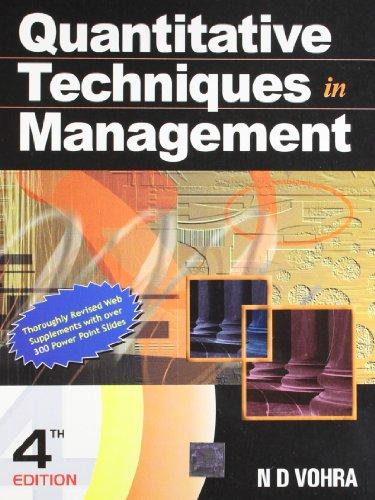32. (a) A retailer gets discount for large orders. The discount is 4 per cent if the...
Question:
32.
(a) A retailer gets discount for large orders. The discount is 4 per cent if the quantity ordered is 500 or more, and an additional 1 per cent discount is received if the quantity ordered is 1,000 or more. The product costs Rs 50 and sells uniformly at the rate of 2,500 per year. The fixed order cost is Rs 50, while the inventory carrying cost is 20% of the value of the average inventory held.
(i) What is the best order quantity?
(ii) What is the minimum total annual cost, including the purchasing cost?
(b) A manufacturer of a line of microwave ovens must decide the manufacturing batch sizes. The setup cost for manufacturing a particular microwave oven is Rs 15,000. The annual rate of sales is 10,000 and the rate of sales is constant during the year. The annual manufacturing capacity is 20,000. The cost of a completed microwave oven is Rs 15,000. The inventory holding cost fraction is 0.01 per year.
(i) What is the most economical batch size (EBQ)?
(ii) What is the minimum annual total of inventory holding and set-up costs?
(iii) What is the number of production runs per year?
(iv) What is the amount of time required for the production of each batch?
(v) What is the maximum inventory on hand for the EBQ?
(c) Assuming that the total annual demand, carrying cost of inventory and ordering/set-up cost are the same, in which of the two conditions will the EOQ be larger and why:
(i) Instantaneous receipt of inventory
(ii) Gradual receipt of inventory
(d) In a certain inventory system, the EOQ is 1000 units. If the demand for the next year increases by 50 per cent, how will be EOQ change? If the inventory carrying cost increases, in addition to the increase in demand, from 25% to 40% of the value of the inventory, what will be the revised EOQ?
(
e) The lead time demand for a continuous review inventory system has a normal distribution, with a mean of 50 units and a standard deviation of 10 units. The order quantity is 300 units and the annual demand is 3600 units.
(i) If it is desired that the probability of shortage in a re-order cycle be 0.05, what should be the reorder level?
(ii) If it is desired that the probability of shortage in a re-order cycle be 0.01, what should be the safety stock?
(iii) What service level can be expected with a safety stock of25 units? (M Com, Delhi, 2004)
Step by Step Answer:







